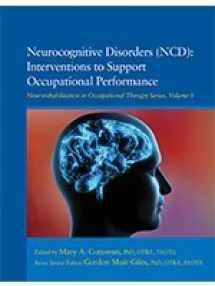
Neurocognitive Disorder (NCD): Interventions to Support Occupational Performance
Book details
Summary
Description
Considered a worldwide epidemic, neurocognitive disorders are the most feared disorder second to cancer. In the United States, 1 in 8 Americans ages 65 or older has an NCD, and this number is predicted to triple by 2050. The most prevalent NCD is Alzheimer's disease.
More than a memory disorder because of progressive deterioration, NCD can affect every aspect of a person's life, from executive functioning, language, and physical functioning; to engagement in activities and occupations; to a person's sense of dignity, personhood, and identity. NCD's impact on the more than 15 million families in the United States who assume daily care responsibilities is profound as well.
Neurocognitive Disorder (NCD): Interventions to Support Occupational Performance offers an understanding of the neurocognitive basis of these disorders in an examination of their psychosocial consequences and treatment implications. Chapter authors, who are clinicians, educators, and researchers, answer the following questions: What can occupational therapy do to support people with NCD and their family members? Who better than occupational therapists to help people more effectively use healthy occupations as preventive measures? and Who better than occupational therapists to address the skill needs of people with NCD and their families?
Occupational therapy-based interventions are emerging as one of the most promising approaches in supporting people with NCD and their families. After reading this publication or completing this Self-Paced Clinical Course (2 AOTA CEUs/25 NBCOT PDUs/20 contact hours), readers will be able to recognize the neurological underpinnings, cognitive and behavioral symptoms, and progression of several major types of NCD; delineate the psychosocial, emotional, and occupational effects of NCD; recognize the factors affecting quality of life for clients with NCD and their family caregivers; recognize the critical role of the primary caregiver and family in the care of people with NCD; recognize the typical effect of NCD on participation in the performance areas of education, work, play, leisure, social participation, ADLs, and IADLs; identify the components of a comprehensive functional evaluation for clients with NCD; delineate the characteristics and benefits of community-based occupational therapy services for clients with NCD and their families; and identify the translational concepts guiding implementation of evidence-based therapeutic interventions for clients with NCD and their family caregivers.
This work can serve as a text for advanced-level occupational therapy students, as well as an SPCC for clinicians needing to develop or expand their clinical competency. Features include Points to Ponder, a glossary, details of NCD neuropathology and color images, and an extended case study in which a hypothetical client is followed through the various stages of intervention.


We would LOVE it if you could help us and other readers by reviewing the book
Book review



